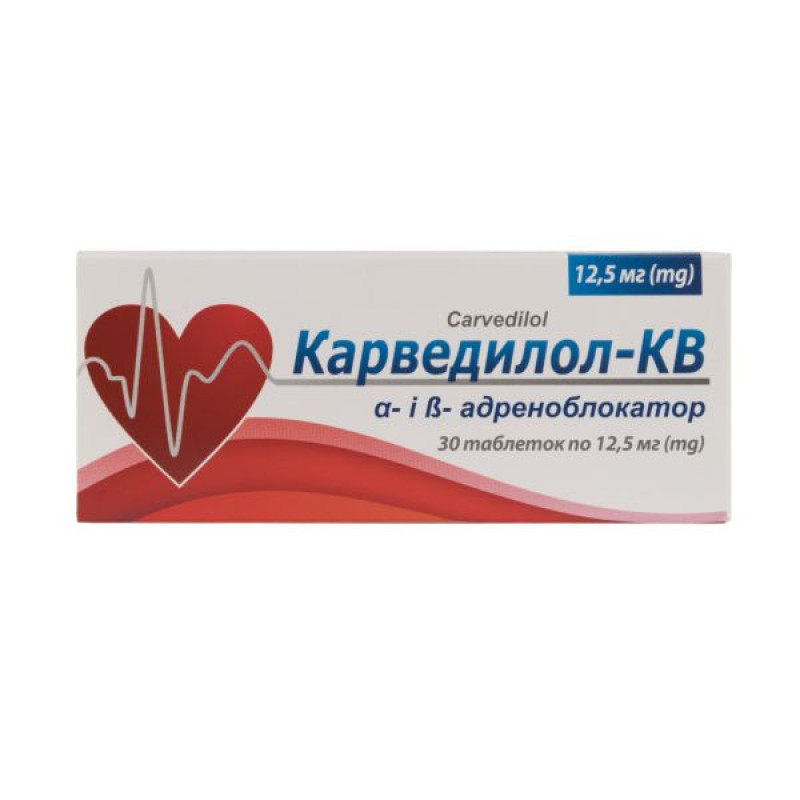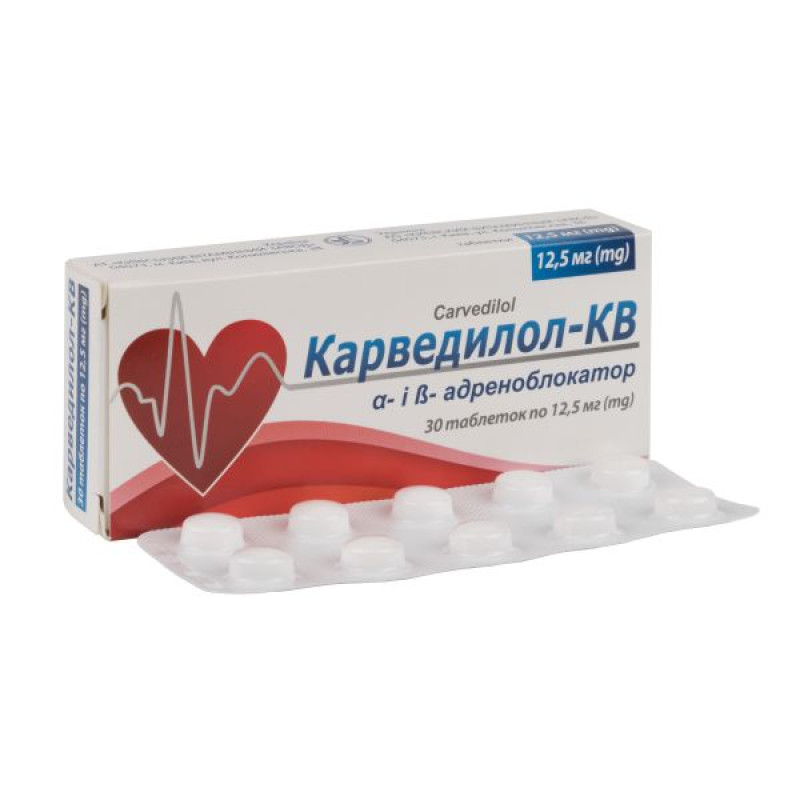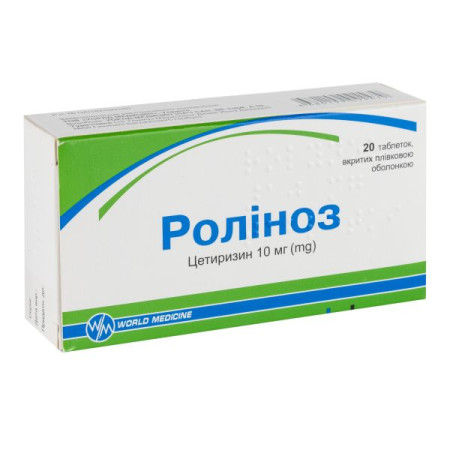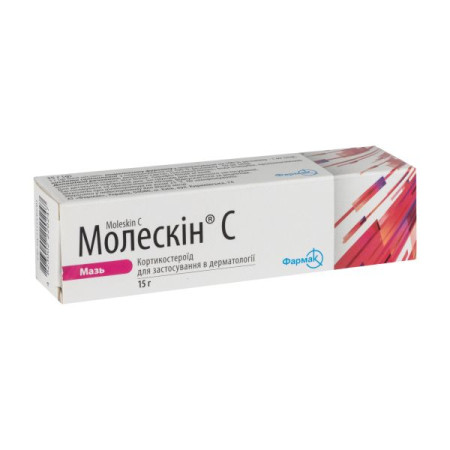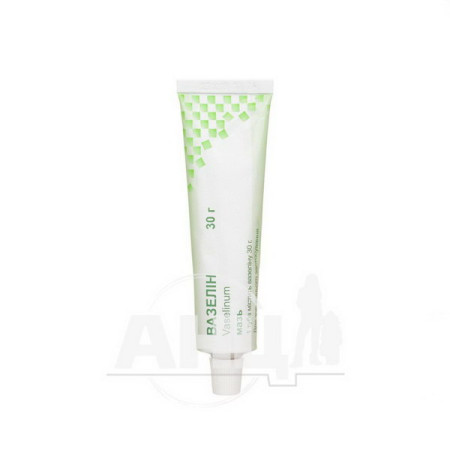Carvedilol-KV tablets 12.5 mg blister No. 30
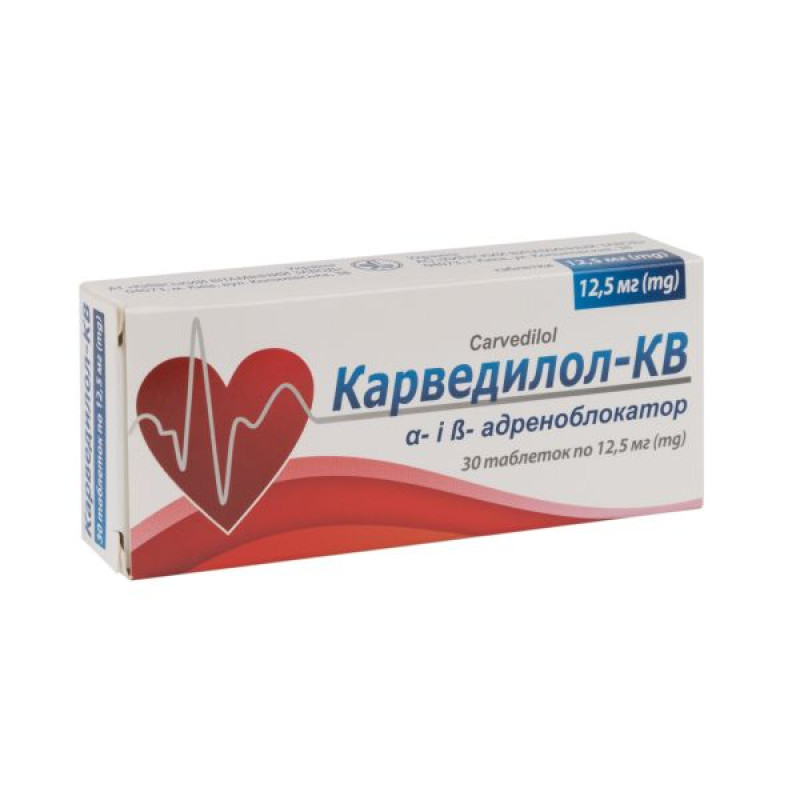
Instructions for Carvedilol-KV tablets 12.5 mg blister No. 30
Composition
active ingredient: carvedilol;
1 tablet contains carvedilol 12.5 mg or 25 mg;
excipients: lactose monohydrate, sugar, povidone, crospovidone, colloidal anhydrous silica, magnesium stearate
Dosage form
Pills.
Main physicochemical properties: round tablets with a biconvex surface, with a score, white or almost white in color.
Pharmacotherapeutic group
α- and β-adrenergic receptor blockers. ATC code C07A G02.
Pharmacological properties
Pharmacodynamics.
Carvedilol is a non-selective β-blocker with vasodilator activity. It also has antioxidant and antiproliferative properties.
The active ingredient carvedilol is a racemate; the enantiomers differ in their effects and metabolism. The S(-) enantiomer has activity directed at blocking both α1- and β-adrenoceptors, while the R(+) enantiomer exhibits activity directed at blocking only α1-adrenoceptors. Due to cardioselective blockade of β-adrenoceptors, it reduces blood pressure, heart rate and cardiac output. Carvedilol reduces pulmonary artery pressure and right atrial pressure. By blocking α1-adrenoceptors, it causes peripheral vasodilation and reduces systemic vascular resistance. Due to these effects, the workload on the heart muscle is reduced and the development of angina is prevented. In patients with heart failure, this leads to an increase in the ejection fraction from the left ventricle and a decrease in the symptoms of the disease. Similar effects have been observed in patients with left ventricular dysfunction. Carvedilol does not exhibit intrinsic sympathomimetic activity, and like propranolol, it has membrane-stabilizing properties.
properties. Renin activity in the blood plasma is reduced, and fluid retention in the body occurs rarely. The effect on blood pressure and heart rate is most pronounced 1-2 hours after administration.
In patients with arterial hypertension on the background of healthy kidneys, carvedilol reduces renal vascular resistance. At the same time, there are no significant changes in glomerular filtration, renal blood flow and electrolyte excretion. Due to the maintenance of peripheral blood flow, cooling of the extremities, characteristic of treatment with β-blockers, rarely occurs.
Carvedilol generally does not affect serum lipoprotein levels.
Pharmacokinetics.
Carvedilol is rapidly and almost completely absorbed after oral administration. It is almost completely bound to plasma proteins. The volume of distribution is approximately 2 l/kg. The plasma concentration is proportional to the applied dose.
Due to extensive first-pass metabolism in the liver (mainly by the hepatic enzymes CYP2D6 and CYP2C9), the bioavailability of carvedilol is only about 30%. Three active metabolites are formed that exhibit β-blocking activity; one of them (the 4'-hydroxyphenyl derivative) has 13 times the β-blocking activity of carvedilol. Compared with carvedilol, the active metabolites have weak vasodilator activity. Metabolism is stereoselective; therefore, plasma levels of R(+) carvedilol are 2-3 times higher than those of S(-) carvedilol. Plasma levels of the active metabolites are about 10 times lower than those of carvedilol. The elimination half-lives vary greatly: 5-9 hours for R(+) carvedilol and 7-11 hours for S(-) carvedilol.
In elderly patients, an increase in carvedilol levels of approximately 50% is observed. In patients with cirrhosis of the liver, the bioavailability of carvedilol is increased 4-fold, and the maximum plasma concentration is 5-fold higher than in healthy subjects. In patients with impaired liver function, the bioavailability increases to 80% due to reduced first-pass metabolism. Since carvedilol is excreted mainly in the feces, significant accumulation of the drug is unlikely in patients with impaired renal function.
The presence of food in the stomach slows down the rate of absorption of the drug, but this does not affect its bioavailability.
Indication
§ Essential hypertension (both mono- and as part of combination therapy).
§ Chronic stable angina.
§ Chronic heart failure of moderate and severe degree, as additional therapy.
Contraindication
Hypersensitivity to the active substance or to any of the excipients of the medicinal product; decompensated heart failure - heart failure of class IV according to the NYHA classification, requiring intravenous administration of inotropic agents; atrioventricular block of the II and III degrees (except in cases where a permanent pacemaker is installed); concomitant intravenous administration of verapamil, diltiazem or other antiarrhythmic agents (especially class I antiarrhythmic agents); severe bradycardia (HR < 50 beats/min); severe hypotension (systolic blood pressure below 85 mm Hg); cardiogenic shock; sick sinus syndrome (including sinoatrial block); uncompensated heart failure, requiring intravenous administration of positive inotropic and/or diuretic agents; cor pulmonale, pulmonary hypertension; bronchial asthma or obstructive airway diseases accompanied by bronchospasm; pheochromocytoma (except when adequately controlled with alpha-blockers); Prinzmetal's angina; severe liver dysfunction; concomitant use of MAO inhibitors (except MAO-B inhibitors); galactose intolerance, Lapp lactase deficiency or glucose-galactose malabsorption; metabolic acidosis; pregnancy or breastfeeding, children's age.
Interaction with other medicinal products and other types of interactions
Some antiarrhythmics, narcotics, antihypertensives, drugs for the treatment of angina, other β-blockers (e.g. in the form of eye drops), drugs that reduce the level of catecholamines (e.g. monoamine oxidase inhibitors, reserpine) and cardiac glycosides may enhance the effects of carvedilol. Therefore, the dose of these drugs and Carvedilol-KV should be selected with caution.
Pharmacokinetic interactions.
Digoxin: Digoxin concentrations are increased by approximately 16% when digoxin and carvedilol are coadministered. Both digoxin and carvedilol slow arteriovenous conduction. Increased monitoring of digoxin levels is recommended when initiating, adjusting, or discontinuing carvedilol.
Insulin or oral hypoglycemic agents: Drugs with β-blocking properties may enhance the blood sugar-lowering effect of insulin and oral hypoglycemic agents. The symptoms of hypoglycemia may be masked or attenuated (especially tachycardia). Therefore, regular monitoring of blood glucose levels is recommended for patients taking insulin or oral hypoglycemic agents.
Inducers or inhibitors of P-glycoprotein, CYP2D6, CYP2D9. Carvedilol is an inhibitor of P-glycoprotein, therefore the bioavailability of drugs transported by P-glycoprotein may increase when used concomitantly with carvedilol.
Inhibitors, as well as inducers of CYP2D6 and CYP2D9, can stereoselectively alter the systemic or presystemic metabolism of carvedilol, increasing or decreasing the plasma concentrations of R- and S-carvedilol.
Fluoxetine: In studies of patients with heart failure, concomitant use of fluoxetine, a potent CYP2D6 inhibitor, has been shown to result in stereoselective inhibition of carvedilol metabolism with a 77% increase in AUC of the R (+) enantiomer.
β-agonist bronchodilators: Non-cardioselective β-blockers antagonize the effects of β-agonist bronchodilators, so these patients require close monitoring.
Hepatic Metabolism Inducers and Inhibitors: Rifampicin decreases carvedilol plasma concentrations by approximately 70%. Cimetidine increases AUC by approximately 30% but does not cause any change in Cmax. Caution may be warranted in those taking mixed-function oxidase inducers, such as rifampicin, as serum carvedilol levels may be decreased, or mixed-function oxidase inhibitors, such as cimetidine, as serum levels may be increased. However, based on the relatively small effect of cimetidine on carvedilol drug levels, the likelihood of any clinically significant interaction is minimal.
Catecholamine-depleting drugs: Patients taking drugs with β-blocking properties and a drug that may deplete catecholamines (e.g. reserpine and monoamine oxidase inhibitors) should be closely monitored for signs of hypotension and/or severe bradycardia.
Antiarrhythmics: Isolated cases of conduction disturbances (rarely with hemodynamic compromise) have been reported when carvedilol and diltiazem have been administered concomitantly. For other drugs with β-blocking properties, ECG and blood pressure monitoring are recommended when carvedilol is administered orally with calcium channel blockers such as verapamil or diltiazem. These drugs should not be administered intravenously.
Careful monitoring of the patient's condition is necessary when carvedilol is used concomitantly with amiodarone (oral) or class I antiarrhythmic drugs. Bradycardia, cardiac arrest, ventricular fibrillation have been reported shortly after the start of treatment with β-blockers in patients receiving concomitant amiodarone. There is a risk of heart failure in the case of concomitant intravenous therapy with class Ia or Ia antiarrhythmic drugs.
Other antihypertensive drugs: Like other drugs with β-blocking activity, carvedilol may enhance the effect of other concomitantly administered drugs that are antihypertensive in action (e.g. β1-receptor antagonists) or may cause hypotension in relation to their side effect profile.
Pharmacodynamic interactions.
Clonidine: Concomitant administration of clonidine with drugs with β-blocking properties may potentiate the blood pressure and heart rate lowering effects. When concomitant treatment with drugs with β-blocking properties and clonidine is terminated, the β-blocking drug should be discontinued first. Then, after a few days, clonidine therapy can be discontinued by gradually reducing the dosage.
Dihydropyridines: When dihydropyridines are used concomitantly with carvedilol, careful patient monitoring is necessary, as cases of heart failure and severe hypotension have been reported.
Nitrates. Enhance the hypotensive effect.
NSAIDs, estrogens and corticosteroids. The antihypertensive effect of carvedilol is weakened by concomitant use of drugs that retain fluid and sodium in the body.
Sympathomimetics, α-mimetics and β-mimetics: With simultaneous use there is a risk of developing arterial hypertension and pronounced bradycardia.
Ergotamine. With simultaneous use, vasoconstriction increases.
Muscle relaxants. When carvedilol is combined with muscle relaxants, neuromuscular blockade is enhanced.
Xanthine derivatives. Should be used with caution with xanthine derivatives (aminophylline, theophylline) due to reduced β-adrenergic blocking effect.
Anesthetics: Extreme caution should be exercised during anesthesia due to the synergistic negative inotropic and hypertensive effects of carvedilol and anesthetics.
Application features
Arterial hypotension. The drug is not recommended for use in patients with low blood pressure.
Orthostatic hypotension. Orthostatic hypotension with dizziness and vertigo, sometimes with fainting, may occur, especially at the beginning of treatment and when the dose of the drug is increased. Patients with heart failure, elderly patients, and patients taking other antihypertensive drugs or diuretics are at greatest risk. These effects can be prevented by using a low initial dose of Carvedilol-KV, carefully increasing the maintenance dose and taking the drug after meals. Patients should be told about measures to avoid orthostatic hypotension (caution when standing up; if dizziness occurs, the patient should sit or lie down).
Chronic heart failure. In most cases, carvedilol should be prescribed in addition to diuretics, ACE inhibitors, digitalis and/or vasodilators in patients with chronic heart failure. Treatment should be initiated in a hospital setting under medical supervision. Therapy should only be initiated if the patient has been stable on standard basic therapy for at least 4 weeks. Patients with severe heart failure, salt depletion or dehydration, the elderly or with low baseline blood pressure should be monitored closely for approximately 2 hours after the first dose or after dose increases, as hypotension may develop. Hypotension due to excessive vasodilation is initially treated by reducing the dose of diuretics, and if symptoms persist, the dose of any ACE inhibitor can be reduced. At the beginning of treatment or during dose increase, worsening of heart failure or fluid retention may occur. In this case, it is necessary to increase the dose of the diuretic. However, in some cases, it may be necessary to reduce the dose or cancel the drug. The dose of carvedilol should not be increased until symptoms associated with worsening heart failure or arterial hypotension due to excessive vasodilation are controlled.
Carvedilol should be prescribed with caution to patients with chronic heart failure who are taking digitalis, as this combination prolongs atrioventricular conduction.
Carvedilol may cause bradycardia. If heart rate is < 55 beats/min and symptoms associated with bradycardia occur, the dose of the drug should be reduced.
Because carvedilol has an inherent negative dromotropic effect, it should be administered with caution to patients with first-degree heart block.
Renal impairment. In patients with heart failure and low blood pressure (systolic blood pressure < 100 mm Hg), ischemic heart disease or systemic atherosclerosis and/or underlying renal failure, reversible deterioration of renal function has been observed during treatment with carvedilol. In patients with heart failure who have such risk factors, renal function should be monitored during titration of carvedilol. If significant deterioration of renal function is observed, the carvedilol dose should be reduced or treatment discontinued.
Diabetes mellitus and hyperthyroidism. β-blockers slow the heart rate and therefore may mask hypoglycemia in patients with diabetes mellitus and thyrotoxicosis in patients with thyroid disease. In patients with heart failure and diabetes mellitus, blood glucose levels may decrease or increase.
Antiarrhythmics: When carvedilol is used concomitantly with calcium channel blockers such as verapamil and diltiazem, or other antiarrhythmics, especially amiodarone, blood pressure and ECG should be monitored, and their simultaneous intravenous administration should be avoided.
Thyrotoxicosis: Carvedilol, like other drugs with β-blocking activity, may mask the symptoms of thyrotoxicosis.
General anesthesia. β-blockers reduce the risk of arrhythmias during anesthesia, but may also increase the risk of hypotension, so some anesthetics should be used with caution.
Liver function impairment. Carvedilol may in very rare cases cause deterioration of liver function. If clinical deterioration is suspected, liver function should be checked. In case of liver failure, the patient should stop taking the drug Carvedilol-KV. As a rule, after discontinuation of treatment, normalization of liver function occurs.
Chronic obstructive pulmonary disease. β-blockers may exacerbate bronchial obstruction; therefore, these drugs are not recommended for use in patients with chronic lung disease. In exceptional cases, the drug may be prescribed to patients with mild lung disease when other drugs are ineffective; however, careful monitoring is necessary. It is important that these patients take the lowest effective dose of the drug. If signs of airway obstruction appear, treatment with Carvedilol-KV should be discontinued immediately.
Peripheral vascular disease and Raynaud's syndrome: Carvedilol should be used with caution in patients with peripheral vascular disease and Raynaud's syndrome, as β-blockers may exacerbate the symptoms of the disease.
Psoriasis. The drug should be prescribed with caution to patients with psoriasis, as it may increase skin reactions.
Prinzmetal's angina. In patients with Prinzmetal's angina, nonselective β-blockers may cause chest pain (the α1-adrenergic blocking effect of carvedilol may prevent this, but there is insufficient clinical experience with carvedilol in Prinzmetal's angina).
Hypersensitivity reactions: Carvedilol should be administered with caution to patients with a history of serious hypersensitivity reactions and those undergoing desensitization, as β-blockers may increase reactivity in allergy tests, increase sensitivity to allergens, and increase the severity of anaphylactic reactions.
Contact lenses: Contact lens wearers should be warned about the possibility of decreased tear production.
The safety and efficacy of Carvedilol-KV in patients under 18 years of age have not been studied, therefore the drug is not recommended for use in such patients.
Important information about the excipients of the medicinal product. The medicinal product contains sugar and lactose. This medicinal product should not be taken by patients with the following disorders: fructose intolerance, lactase deficiency, galactosemia, glucose-galactose malabsorption syndrome or sucrase-isomaltase deficiency.
Patients are not recommended to drink alcoholic beverages during treatment, as alcohol may enhance the effects of carvedilol.
Since the medicine contains sugar, this should be taken into account by patients with diabetes.
Use during pregnancy or breastfeeding
There are insufficient clinical data on the effects of carvedilol on pregnancy. The results of animal experiments are insufficient to assess the effects during pregnancy, the effects on fetal development and the effects on the child after birth. The potential risk to humans remains unknown.
Beta-blockers have dangerous pharmacological effects on the fetus. They can cause fetal hypotension, bradycardia, and hypoglycemia.
The drug is contraindicated during pregnancy.
Since there is a possibility that carvedilol passes into breast milk, breastfeeding should be discontinued during treatment with the drug.
Ability to influence reaction speed when driving vehicles or other mechanisms
At the beginning of treatment with carvedilol, patients may experience dizziness and increased fatigue, which may indicate the development of postural hypotension and loss of consciousness, so they should refrain from driving vehicles and working with potentially dangerous mechanisms.
Method of administration and doses
To slow down absorption and prevent orthostatic effects, carvedilol should be taken after meals. The dose should be selected individually. Treatment should be started with low doses, which should be gradually increased until the optimal clinical effect is achieved. After the first dose and after each dose increase, it is recommended to measure the patient's blood pressure in the standing position 1 hour after administration to exclude possible arterial hypotension.
Treatment with the drug should be discontinued gradually by reducing the dose over 1 or 2 weeks.
If treatment has been interrupted for more than 2 weeks, its resumption should be started at the lowest dose.
Essential hypertension. The initial dose of carvedilol is 12.5 mg in the morning after breakfast or 6.25 mg 2 times a day (morning and evening). After 2 days of treatment, the dose should be increased to 25 mg in the morning (1 tablet of 25 mg) or to 12.5 mg 2 times a day. After 14 days of treatment, the dose can be increased again to 25 mg 2 times a day.
The maximum dose of the drug for the treatment of arterial hypertension is 25 mg 2 times a day.
The recommended initial dose of carvedilol for the treatment of hypertension in patients with heart failure is 3.125 mg twice daily.
If a dose of 3.125 mg is required, carvedilol dosage forms with the appropriate active ingredient content should be prescribed.
Chronic stable angina. The initial dose of carvedilol is 12.5 mg 2 times a day after meals. After 2 days of treatment, the dose should be increased to 25 mg 2 times a day.
The maximum dose of carvedilol for the treatment of chronic angina is 25 mg twice daily. The recommended initial dose of carvedilol for the treatment of angina in patients with heart failure is 3.125 mg twice daily.
Chronic heart failure. Carvedilol is recommended for the treatment of stable mild to moderate or severe chronic heart failure as an adjunct to standard medications such as diuretics, ACE inhibitors, or digitalis. The drug can also be taken by patients who are intolerant to ACE inhibitors. The patient should only be prescribed carvedilol after the diuretic, ACE inhibitor, and digitalis (if applicable) doses have been titrated.
At the beginning of treatment with the drug or after increasing the dose, a transient increase in heart failure may occur. In this case, it is necessary to increase the dose of the diuretic. Sometimes it is necessary to temporarily reduce the dose of carvedilol or even cancel it. After stabilization of the clinical condition, carvedilol treatment can be resumed or its dose increased.
The initial dose is 3.125 mg twice daily. If the patient tolerates this dose well, it can be gradually increased (every 2 weeks) until the optimal dose is reached. Subsequent doses are 6.25 mg twice daily, then 12.5 mg twice daily and 25 mg twice daily. The patient should take the highest dose that is well tolerated. The maximum recommended dose is 25 mg twice daily. For patients weighing more than 85 kg, the dose can be cautiously increased to 50 mg twice daily.
Elderly patients: No dose adjustment is required.
Patients with hepatic insufficiency. The drug Carvedilol-KV is not recommended for use in patients with severe hepatic insufficiency.
Patients with renal insufficiency: No specific dose adjustment is required for patients with systolic blood pressure above 100 mm Hg (see also section 4.4).
Children
There is no information on the safety and effectiveness of Carvedilol-KV in children, therefore the use of the drug in children is contraindicated.
Overdose
Symptoms: pronounced decrease in blood pressure (BP), bradycardia, heart failure, cardiogenic shock, cardiac arrest; possible respiratory disorders, bronchospasm, vomiting, confusion and generalized convulsions.
Treatment: In addition to general measures, it is necessary to monitor and correct vital signs, if necessary - in the intensive care unit. The following measures can be used:
a) lay the patient on his back;
b) with severe bradycardia – atropine 0.5-2 mg intravenously;
c) to support cardiovascular activity – glucagon 1-10 mg intravenously by jet, then 2-5 mg per hour as a continuous infusion;
d) sympathomimetics (dobutamine, isoprenaline, orciprenaline or adrenaline) in different doses, depending on body weight and therapeutic efficacy.
If necessary, the administration of drugs with a positive isotropic effect should be prescribed phosphodiesterase inhibitors. If the clinical picture of overdose is dominated by arterial hypotension, administer noradrenaline; it should be administered under conditions of continuous monitoring of blood circulation indicators.
In case of bradycardia resistant to treatment, the use of an artificial pacemaker is indicated. In case of bronchospasm, administer β-adrenomimetics in the form of an aerosol (if ineffective, intravenously) or aminophylline intravenously. In case of convulsions, administer diazepam or clonazepam intravenously slowly. Since in case of severe overdose with symptoms of shock, the half-life of the drug from the depot may be prolonged, it is necessary to continue supportive therapy for a sufficiently long time. The duration of supportive detoxification therapy depends on the severity of the overdose; it should be continued until the patient's condition stabilizes.
Carvedilol cannot be removed by dialysis.
In the event of a serious overdose, when the patient is in a state of cardiogenic shock, supportive treatment should be provided for a sufficiently long time, since the elimination or redistribution of carvedilol may be slower than usual.
Side effects
Infections and infestations: bronchitis, pneumonia, upper respiratory tract infections, urinary tract infections.
On the part of the immune system: hypersensitivity (allergic reaction).
From the side of the central nervous system: headache, dizziness, fatigue; depression, sleep disturbances, paresthesia, vertigo.
Cardiovascular system: postural hypotension, bradycardia, hypertension, loss of consciousness, especially at the beginning of treatment, angina pectoris, increased heart rate; peripheral blood flow disorders, orthostatic reactions, intermittent claudication or Raynaud's disease, peripheral edema, atrioventricular block, worsening of heart failure.
Respiratory system: shortness of breath, pulmonary edema, bronchial asthma, nasal congestion.
On the part of the digestive system: nausea, diarrhea, abdominal pain, dry mouth, constipation, vomiting, periodontitis, melena.
Skin: rash, itching; urticaria; reactions resembling lichen planus; increased sweating; the appearance of psoriatic plaques or exacerbation of psoriasis; alopecia; allergic exanthema; dermatitis.
On the part of the organs of vision: decreased lacrimation, visual impairment, eye irritation.
Metabolic disorders: weight gain, hypervolemia, fluid retention.
Musculoskeletal system: pain in the extremities, arthralgia, cramps.
From the genitourinary system: urination disorders, impotence; renal dysfunction in patients with diffuse peripheral arterial disease, renal failure, hematuria, albuminuria, urinary incontinence in women.
Laboratory indicators: increased serum transaminase levels; thrombocytopenia, leukopenia, anemia, decreased prothrombin levels, impaired blood glucose control (hyperglycemia, hypoglycemia) in patients with pre-existing diabetes mellitus; hypercholesterolemia, glycosuria, hyperkalemia, hypertriglyceridemia, hyponatremia, increased levels of alkaline phosphatase, creatinine, urea, hyperuricemia.
Other side effects: flu-like symptoms, fever; hypoesthesia, anaphylactic reactions, possible manifestations of latent diabetes, symptoms of existing diabetes may worsen during therapy, depressed mood, asthenia, pain.
With the exception of dizziness, visual disturbances and bradycardia, none of the side effects described above are dose-dependent.
Expiration date
3 years.
Storage conditions
Store in the original packaging at a temperature not exceeding 25 ºС.
Keep out of reach of children.
Packaging
10 tablets in a blister; 3 blisters in a pack.
Vacation category
According to the recipe.
Producer
JSC "KYIV VITAMIN FACTORY".
Address
04073, Ukraine, Kyiv, Kopylivska St., 38.
Website: www.vitamin.com.ua.
There are no reviews for this product.
There are no reviews for this product, be the first to leave your review.
No questions about this product, be the first and ask your question.







